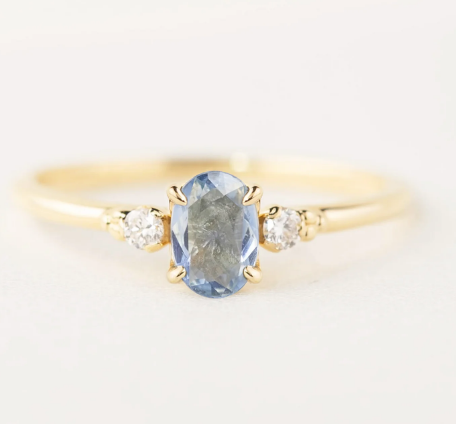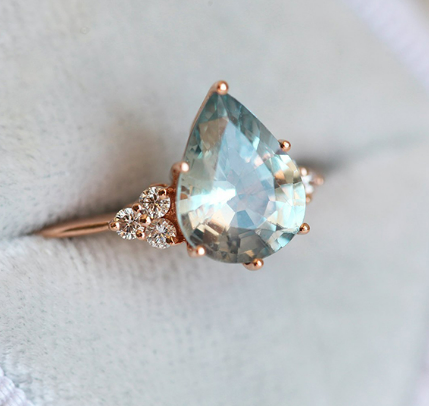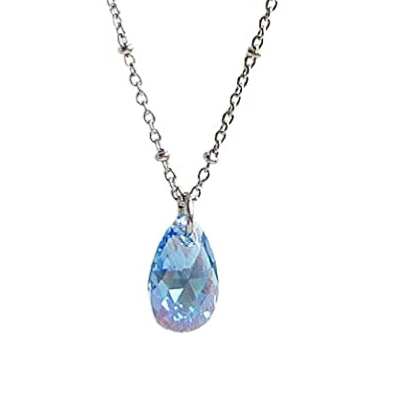Tiffany blue synthetic raw sapphire gemstone’s abstract
The Tiffany blue synthetic raw sapphire gemstone stands as a captivating testament to innovation in gemstone manufacturing, capturing the enduring charm and sophistication of natural sapphires while presenting distinct advantages in color uniformity and ethical procurement. This expanded abstract delves into the gemstone’s commercial viability, emphasizing its artificial origin and its potential applications in jewelry design and adornment.
- Commercial Value: As a synthetic gemstone, the Tiffany blue raw sapphire offers significant commercial value by providing a reliable and consistent source of high-quality gemstones. Jewelry manufacturers and designers can depend on the gemstone’s consistent color and clarity, streamlining production processes and ensuring customer satisfaction. Additionally, the ethical and sustainable nature of synthetic gemstone production appeals to environmentally conscious consumers, enhancing the gemstone’s marketability.
- Unique Selling Proposition: The artificial origin of the Tiffany blue raw sapphire distinguishes it in the market, offering a compelling story of innovation and sustainability. Its vibrant hue and flawless clarity rival those of natural sapphires, presenting an attractive alternative for consumers seeking beauty without compromising their values. Jewelry retailers can leverage the gemstone’s unique selling proposition to differentiate their offerings and attract discerning customers.
- Applications in Jewelry Design: It opens up a world of creative possibilities in jewelry design and decoration. Its raw form allows artisans and designers to explore unique shapes, cuts, and settings, unleashing their creativity and imagination. From statement rings to delicate earrings and intricate necklaces, the gemstone lends itself to a myriad of designs, each showcasing its unparalleled beauty and allure.
In conclusion, It not only embodies the essence of natural sapphires but also offers distinct advantages in terms of consistency, sustainability, and versatility. Its commercial value lies in its ability to meet the demands of both consumers and industry professionals, serving as a testament to the transformative power of innovation in the gemstone market.
Tiffany blue synthetic raw sapphire gemstone’s showcase
Tiffany blue synthetic raw sapphire gemstone’s Characteristics
he characteristics of the Tiffany blue synthetic raw sapphire gemstone are as follows:
- Color: It exhibits a distinctive hue reminiscent of the iconic Tiffany blue color. This vibrant and enchanting shade captures attention and evokes a sense of elegance and sophistication.
- Clarity: These synthetic gemstones often possess exceptional clarity, with minimal to no visible inclusions or imperfections. The high clarity enhances the gemstone’s brilliance and transparency, allowing light to pass through and refract beautifully.
- Texture: The surface texture of the Tiffany blue synthetic raw sapphire gemstone is typically smooth and polished, enhancing its luster and shine. This smooth texture adds to the gemstone’s visual appeal and luxurious feel.
- Hardness: Synthetic sapphire gemstones, including the Tiffany blue variety, have a high level of hardness, ranking 9 on the Mohs scale. This exceptional hardness makes them durable and resistant to scratches, ensuring longevity and durability in jewelry and other applications.
- Size and Shape:they are available in various sizes and shapes to suit different preferences and design requirements. From small accent stones to larger focal points, these gemstones offer versatility and flexibility in jewelry design.
- Origin: As synthetic gemstones, Tiffany blue raw sapphires are created in controlled laboratory environments using advanced manufacturing techniques. Their artificial origin ensures consistency in color, clarity, and quality, providing a reliable and sustainable source of gemstones.
- Ethical Sourcing: Synthetic gemstones like the Tiffany blue raw sapphire offer an ethical and sustainable alternative to natural gemstones. They are produced without the environmental and ethical concerns associated with traditional mining practices, making them a responsible choice for environmentally conscious consumers.
Overall, it exhibits a captivating combination of color, clarity, and ethical sourcing, making it an attractive option for jewelry designers, collectors, and enthusiasts alike. Its distinctive characteristics and ethical credentials set it apart in the world of gemstones, offering beauty with a conscience.
Tiffany blue synthetic raw sapphire gemstone’s Production Methods
- high-pressure, high-temperature aqueous solution. Aluminum oxide powder, along with specific dopants to achieve the Tiffany blue color, is dissolved in the solution. Through controlled heating and cooling processes, synthetic sapphire crystals with the desired color and purity are grown over time. The hydrothermal method offers excellent control over crystal growth and allows for the production of large, high-quality gemstones.
- Flux Method: In the flux method, aluminum oxide powder is mixed with a chemical flux and heated to high temperatures until it forms a molten solution. Various additives are introduced to achieve the Tiffany blue coloration. As the solution cools, synthetic sapphire crystals precipitate out and can be harvested. The flux method enables the production of synthetic sapphire gemstones with specific color variations and optical properties.
- Verneuil Method (Flame Fusion): The Verneuil method involves melting aluminum oxide powder in a high-temperature flame and allowing it to crystallize as it descends onto a rotating pedestal. To achieve the Tiffany blue color, specific dopants are added to the aluminum oxide feedstock. While the Verneuil method is known for its efficiency and scalability, achieving precise color control may require additional adjustments in the production process.
- Czochralski Method: The Czochralski method entails slowly pulling a seed crystal from a molten solution of aluminum oxide. Dopants are carefully added to the solution to impart the desired Tiffany blue color to the synthetic sapphire crystal. This method allows for the production of large, single-crystal gemstones with excellent clarity and uniformity. While the Czochralski method requires precise control and specialized equipment, it offers unparalleled quality in synthetic gemstone production.
These production methods ensure that Tiffany blue synthetic raw sapphire gemstones meet stringent quality standards while offering the desired color consistency and ethical sourcing. By utilizing advanced manufacturing techniques and meticulous quality control measures, manufacturers can produce synthetic gemstones that rival natural sapphires in beauty and appeal.
Tiffany blue synthetic raw sapphire gemstone’s applications
The Tiffany blue synthetic raw sapphire gemstone holds immense potential for various applications across multiple industries, particularly in jewelry design and decorative arts. Here are some key applications:
- Jewelry Design: It is widely used in jewelry design to create stunning pieces such as rings, earrings, necklaces, bracelets, and pendants. Its vibrant blue hue adds a touch of elegance and sophistication to any jewelry creation, making it a popular choice among designers and consumers alike.
- Fashion Accessories: The gemstone is also utilized in the production of fashion accessories such as brooches, hairpins, and embellishments for clothing and handbags. Its striking color and lustrous appearance make it a versatile option for adding a pop of color and glamour to various fashion accessories.
- Lapidary Art: Lapidaries and artisans often incorporate them into their artistic creations, including sculptures, carvings, and decorative objects. The gemstone’s raw form allows for creative experimentation with shapes, textures, and finishes, resulting in unique and eye-catching art pieces.
- Birthstone Jewelry: The Tiffany blue synthetic raw sapphire gemstone is an alternative birthstone for the month of September. Jewelry designers frequently use it to create birthstone jewelry pieces for individuals born in September, offering them a beautiful and meaningful way to celebrate their birth month.
- Customized Gifts: The gemstone’s vibrant color and versatility make it an ideal choice for customized gifts and keepsakes. Whether it’s a personalized pendant, engraved ring, or monogrammed bracelet,it adds a special touch to any gift, symbolizing love, friendship, and appreciation.
- Corporate Awards and Recognition: Companies and organizations often choose it to create custom-designed awards and recognition items. The gemstone’s striking color and high-quality finish make it a prestigious choice for honoring achievements and milestones in various industries.
- Educational and Research Purposes: Synthetic gemstones like the Tiffany blue raw sapphire are used in educational settings and scientific research laboratories for studying gemstone properties, conducting experiments, and training gemologists. Their consistent color and clarity make them valuable tools for learning and analysis.
Overall, it offers endless possibilities for creative expression and personalization across a wide range of applications, making it a versatile and sought-after gemstone in the global market.
Tiffany blue synthetic raw sapphire gemstone’s properties
It boasts a set of properties that make it a highly desirable and versatile option for various applications in jewelry and decorative arts. Here are its key properties:
- Color: The gemstone exhibits a captivating Tiffany blue hue, reminiscent of the iconic color associated with the renowned jewelry brand. This vibrant and enchanting shade evokes a sense of elegance and sophistication, making it a popular choice for jewelry and fashion accessories.
- Clarity: Tiffany blue synthetic raw sapphire gemstones typically display excellent clarity, with minimal to no visible inclusions or imperfections. This high clarity enhances the gemstone’s brilliance and transparency, allowing light to pass through and refract beautifully.
- Hardness: Synthetic sapphire gemstones, including the Tiffany blue variety, boast exceptional hardness, ranking 9 on the Mohs scale. This remarkable hardness makes them highly resistant to scratches and abrasions, ensuring durability and longevity in jewelry and other applications.
- Luster: The gemstone features a striking luster that adds to its visual appeal and allure. When properly cut and polished, it exhibits a brilliant shine and sparkle that enhances its beauty and elegance.
- Transparency: They are often highly transparent, allowing light to pass through them easily. This transparency enhances the gemstone’s color saturation and clarity, making it visually stunning and captivating.
- Cut: The gemstone is available in various cuts and shapes, ranging from traditional to contemporary designs. Whether it’s a classic round cut or a modern princess cut, the Tiffany blue synthetic raw sapphire gemstone can be tailored to suit different preferences and design requirements.
- Origin: As a synthetic gemstone, the Tiffany blue raw sapphire is created in controlled laboratory environments using advanced manufacturing techniques. Its artificial origin ensures consistency in color, clarity, and quality, providing a reliable and sustainable source of gemstones.
- Ethical Sourcing: Synthetic gemstones like the Tiffany blue raw sapphire offer an ethical and sustainable alternative to natural gemstones. They are produced without the environmental and ethical concerns associated with traditional mining practices, making them a responsible choice for environmentally conscious consumers.
Overall, the Tiffany blue synthetic raw sapphire gemstone combines stunning color, exceptional clarity, and ethical sourcing, making it a sought-after gemstone for jewelry designers, collectors, and enthusiasts alike. Its unique properties set it apart in the world of gemstones, offering beauty with a conscience.
Tiffany blue synthetic raw sapphire gemstone’s development trends
The development trends of Tiffany blue synthetic raw sapphire gemstones are influenced by various factors, including technological advancements, consumer preferences, and market dynamics. Here are some key trends shaping the future of these gemstones:
- Advanced Manufacturing Techniques: Technological innovations in gemstone synthesis are expected to continue, leading to further improvements in the production efficiency and quality of Tiffany blue synthetic raw sapphire gemstones. Advancements in hydrothermal and flux methods, as well as the development of novel synthesis processes, may result in gemstones with enhanced color consistency, clarity, and brilliance.
- Customization and Personalization: There is a growing demand for customized and personalized jewelry pieces, driving the trend towards bespoke designs featuring Tiffany blue synthetic raw sapphire gemstones. Jewelry manufacturers and designers are likely to offer more options for customization, allowing customers to create unique and one-of-a-kind pieces that reflect their individual style and preferences.
- Sustainable and Ethical Sourcing: With increasing awareness of environmental and ethical issues, consumers are seeking sustainable and ethically sourced gemstones. Tiffany blue synthetic raw sapphire gemstones, being produced in controlled laboratory settings without the environmental impact of mining, are well-positioned to meet this demand. Manufacturers may emphasize their ethical sourcing practices as a key selling point to attract environmentally conscious consumers.
- Integration of Technology: The integration of technology, such as 3D printing and computer-aided design (CAD), into the jewelry manufacturing process is expected to influence the design and production of Tiffany blue synthetic raw sapphire gemstone jewelry. These technologies enable greater precision, efficiency, and creativity in jewelry design, allowing designers to explore innovative shapes, textures, and patterns.
- Market Expansion: The market for Tiffany blue synthetic raw sapphire gemstones is likely to expand as consumer awareness grows and demand increases. Emerging markets in Asia-Pacific, particularly China and India, present significant opportunities for growth due to rising disposable incomes and increasing interest in luxury goods. Manufacturers may focus on expanding their distribution networks and establishing partnerships with retailers to tap into these markets.
- Collaborations and Partnerships: Collaborations between jewelry designers, manufacturers, and technology companies may lead to the development of new products and designs featuring Tiffany blue synthetic raw sapphire gemstones. Partnerships with fashion brands, celebrities, and influencers could also help to raise awareness and drive demand for these gemstones.
Overall, the future of Tiffany blue synthetic raw sapphire gemstones looks promising, with continued innovation, sustainability, and customization driving growth and market adoption. As consumer preferences evolve and technology advances, these gemstones are expected to remain a popular choice for discerning jewelry enthusiasts seeking beauty, quality, and ethical sourcing.
Q&A
Are synthetic sapphires worth anything?
In general, lab-created sapphires are less valuable than natural sapphires. However, this is not always the case. In some instances, lab-created sapphires can be more valuable than natural sapphires, depending on the stone’s quality.
How can you tell if a sapphire is synthetic?
Natural Sapphires tend to have inclusions and some synthetic ones tend to have air bubbles. you can also perform a breath test to judge authenticity. If you breathe on a natural sapphire the fog will evaporate almost instantly. If it is a fake sapphire the breath fog will take more than 5 seconds to evaporate.
Are synthetic sapphires cheap?
Only some people can afford to wear jewelry with real blue sapphire stones, as a top-quality blue sapphire can cost upto $10,000 to $50,000 a carat. But most people can afford to wear jewelry with Synthetic Blue Sapphire in it as you can easily find a top quality Lab Created Blue Sapphire at gems for below $100.
Synthetic sapphires are often more affordable than their natural counterparts, but whether they are considered “cheap” depends on various factors. Here’s a breakdown:
- Cost Comparison: Synthetic sapphires are generally less expensive to produce than natural sapphires because they are created in controlled laboratory environments rather than mined from the earth. This means that the costs associated with mining, extraction, and transportation are eliminated. As a result, synthetic sapphires are typically more affordable.
- Quality and Value: While synthetic sapphires are more budget-friendly, they can still offer excellent quality and value. Modern synthesis techniques produce synthetic gemstones that closely resemble natural sapphires in terms of color, clarity, and hardness. Many people find that synthetic sapphires offer a cost-effective way to enjoy the beauty and durability of sapphires without the higher price tag of natural stones.
- Perception and Preference: The perception of synthetic sapphires as “cheap” can vary among individuals and cultures. Some people may value the uniqueness and rarity of natural gemstones and prefer to invest in them, while others may appreciate the affordability and ethical sourcing of synthetic alternatives. Ultimately, the choice between synthetic and natural sapphires often comes down to personal preference and budget considerations.
- Market Factors: Market demand and supply also influence the pricing of synthetic sapphires. As technology advances and production volumes increase, the cost of producing synthetic gemstones may decrease, leading to lower prices for consumers. Additionally, factors such as gemstone size, color, and clarity can affect pricing, with larger, more vivid, and higher-quality synthetic sapphires commanding higher prices.
In summary, while synthetic sapphires are generally more affordable than natural sapphires, they are not necessarily considered “cheap” in terms of quality or value. Many people appreciate the affordability, durability, and ethical sourcing of synthetic gemstones, making them a popular choice for various jewelry and decorative applications.




